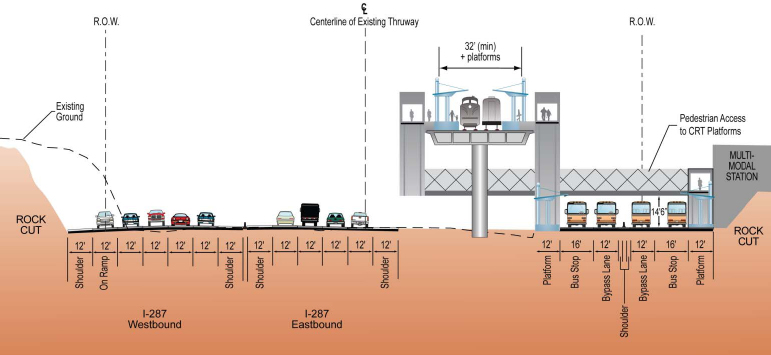Since October, when Governor Cuomo announced the fast-tracking of the Tappan Zee Bridge replacement project, New York State has used the allegedly prohibitive cost of transit to justify omitting transit from the bridge. In the draft environmental impact statement for the project released in January, the state claimed that a bus rapid transit (BRT) system in the I-287 corridor would cost $4.5-$5.2 billion, putting the price tag on par with the cost of building two new bridge spans. Yet, in 2009, the state estimated that a bus rapid transit system through the corridor would range between $900 million and $2.5 billion. The discrepancy caused many raised eyebrows and double-takes.
Now, Tri-State Transportation Campaign may have discovered why the state’s figures are so high. In a press release issued today [pdf], the Campaign announced that its preliminary analysis of state documents—received 129 days after the filing of a Freedom of Information Law request prompted by this unexplained spike in cost—suggests that the state never analyzed the price of a simple BRT only option, instead relying on outdated information from a significantly larger project.
The state’s estimate for BRT appears to be based on figures from the old Tappan Zee Bridge/I-287 Corridor Project, a study that was terminated when Governor Cuomo fast-tracked the Tappan Zee Bridge replacement. The cost documents predate October 2011, when the new project was announced.
The use of these old project numbers might explain the state’s outsized cost estimates for a simple BRT system, since the study contemplated an elaborate I-287 corridor that made provisions for BRT, commuter rail transit (CRT), and climbing lanes for trucks. A sample cross section of the Rockland corridor before and after the expansion can be seen below.

The high cost estimates for such an extensive project make sense: it clearly required a lot of work. However, most of this build-out was due to the inclusion of a climbing lane and commuter rail accommodations, neither of which is necessary for a bus rapid transit system in the I-287 corridor. Each scenario comingles costs for all elements of the project. Accordingly, many of the high-cost construction aspects of the older project, like retaining walls, rock blasting, infill, interchange additions, and tunnels, likely would not be necessary in a slightly wider corridor that could accommodate buses. These extraneous construction costs could help explain why New York State’s cost estimate for BRT is approximately five times the industry average.
But many of these costs are irrelevant to the installation of a lean, cost-effective enhanced bus service system—one that is not only inexpensive and easy to implement, but also easily integrated into a fully built-out corridor (if and when funding permits).
The Tappan Zee Bridge project is too important to the Lower Hudson Valley to proceed on the basis of these questionable cost estimates. The state should complete a thoroughly-documented cost analysis of a bus rapid transit system in the corridor that includes simple bus improvements in the short term and more enhanced bus rapid transit in the future.

Why build ANY more highway lanes? We have just had a record heat wave breaking thousands of heat records across the USA from Climate Change with major fuel provided by our Auto Addiction which directly generates 38% of US Greenhouse Emissions. We are facing Peak Oil and the price of oil is already rebounding despite the World’s economic depression. We have already gone past Peak Cars in 2006 and miles driven in New Jersey, New York and the USA is declining as cars get more and more expensive to buy, fuel and maintain. The price of asphalt for the endless highway repaving necessary to sustain Auto Addiction has quadrupled in the last 5 years and is sure to
rise with the price of oil.
Nor do we need Bus Rapid Transit – we need RAIL only across the Hudson at
Tappan Zee which would begin the process of connecting to Metronorth and Amtrak at Tarrytown, potential LightRail by Nyack, and connect 10 major train lines in New Jersey by going down the median of I87/287 connecting at
Nyack, Mahwah, Boonton, Morristown, Basking Ridge, Bridgewater, New Brunswick and Perth Amboy.
New Jersey can be proud of taking leadership in solar and wind energy. We built the first highways as Auto Addiction took over. Now it is time for New Jersey to lead in Green Transit by running and connecting the 996 miles of Rail we already have and making the Jersey Crescent I87/287 Rail Line to connect all points of North/Central New Jersey and New York.
[…] transit (BRT) along a 30-mile stretch of the I-287 corridor, according to New York State. But—as Tri-State, Streetsblog, and Westchester County Executive Rob Astorino have all pointed out—this figure is […]